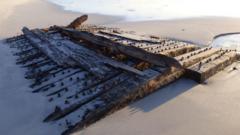Could This Wreck Be a Ship from the American Revolutionary War?

Discovering the HMS Hind: Unearthing a 250-Year-Old Shipwreck in Orkney
The recent discovery of a 250-year-old shipwreck on the island of Sanday in Orkney has captivated archaeologists and historians alike. This significant find, believed to be the wreck of the Earl of Chatham, formerly known as HMS Hind, opens a treasure trove of insights into maritime history and the lives of sailors from centuries past. As the wreck was unearthed during a storm, scientific analysis and community involvement played pivotal roles in its identification. In this article, we will delve deeper into the history of HMS Hind, the research efforts behind its identification, and the broader implications of such discoveries in our understanding of maritime heritage.
The Historical Significance of HMS Hind
HMS Hind was a sixth-rate 24-gun frigate that saw extensive service in the Royal Navy during the 18th century. Launched in 1747, this vessel played a crucial role in significant naval engagements, including the sieges of Louisbourg and Quebec during the French and Indian War in the 1750s. Its transition from a Royal Navy frigate to a whaling ship highlights the adaptability of naval vessels during that era, a common practice among many ships of the time. This repurposing was driven by the need for sturdy ships that could withstand the harsh conditions of the Arctic whaling routes.
From Warship to Whaler: The Transformation of HMS Hind
After its time in military service, HMS Hind was renamed the Earl of Chatham as it embarked on a new life in the whaling industry. The ship completed four successful seasons of whaling in the Arctic before meeting its tragic end in March 1788 in the Bay of Lopness. Remarkably, it was carrying 56 sailors at the time, all of whom survived the ship's sinking. The transition from a vessel of war to one of commerce reflects not only the pragmatic decisions made by shipowners but also the economic realities of the period.
The Discovery of the Wreck
The timbers of the Earl of Chatham were first discovered by the local community of Sanday in February of last year. Strong storms had released the wreck from the seabed, making it visible for the first time in centuries. The discovery ignited interest among local historians and archaeologists, leading to extensive research to confirm the ship's identity. The community's role in finding the wreck emphasizes the importance of local knowledge and engagement in archaeological endeavors.
Conservation Efforts: Preserving the Wreck
Currently, the timbers of the wreck are housed in a freshwater tank at the Sanday Heritage Centre. This conservation effort, funded by the National Heritage Memorial Fund, is crucial for preventing decay. Once removed from the sea, the wooden timbers are susceptible to drying out and breaking down, which could lead to irreversible damage. The freshwater tank serves to stabilize the timbers, allowing for further analysis and potential exhibition in the future.
Scientific Analysis: The Role of Dendrochronology
Identifying the wreck involved a meticulous scientific analysis, including dendrochronological assessment. This method, commonly known as tree ring dating, involves counting the rings in the wood to determine the age of the trees used in construction. The analysis indicated that the wood used in building HMS Hind came from south and southwest England. Such insights not only help confirm the ship's identity but also contribute to understanding the timber trade and shipbuilding practices of the time.
Community Involvement: A Collaborative Effort
The collaboration between local volunteers and professionals from Wessex Archaeology, alongside the Dendrochronicle team, exemplifies how community-led research can enhance historical understanding. Ben Saunders, a senior marine archaeologist at Wessex Archaeology, remarked on the project’s significance, stating that it not only revealed much about the wreck itself but also about the community's relationship with maritime activities in the 1780s. Sanday's reputation as “the cradle of shipwrecks in Scotland” reflects both the peril of its coastal waters and the resilience of its inhabitants.
Implications of the Wreck Discovery
The discovery of HMS Hind carries broader implications for our understanding of maritime history and the socio-economic dynamics of the time. As climate change continues to alter coastlines and sea levels, it is likely that more shipwrecks will emerge from their watery graves. This underscores the importance of archaeological and conservation efforts to document and preserve these historical artifacts before they are lost once again.
Future Prospects for the Sanday Community
As knowledge about the wreck grows, community leaders like Clive Struver emphasize the importance of involving local perspectives in the next steps of the project. Understanding what the Sanday community wants to see happen with the wreck's findings can lead to meaningful educational and tourism opportunities. This collaborative approach ensures that the community remains a central part of its own history, fostering pride and interest in local heritage.
Key Takeaways from the HMS Hind Discovery
The unearthing of the HMS Hind shipwreck serves as a reminder of the rich maritime history that surrounds the Orkney Islands. From its initial role in naval warfare to its life as a whaling ship, the story of this vessel is a testament to the adaptability and resilience of maritime practices. Furthermore, the community's active participation in the discovery process highlights the vital role that local history and collective memory play in preserving our understanding of the past.
FAQs
What was HMS Hind before it became the Earl of Chatham?
HMS Hind was originally a sixth-rate 24-gun frigate in the Royal Navy, actively serving in significant naval engagements before being converted into a whaling ship.
When did the Earl of Chatham sink?
The Earl of Chatham sank in March 1788 in the Bay of Lopness, while carrying 56 sailors, all of whom survived the incident.
How are shipwrecks like HMS Hind identified?
Shipwrecks are identified through a combination of scientific analysis, such as dendrochronology, and community-led research efforts that examine historical records and local knowledge.
Why is community involvement important in archaeological projects?
Community involvement is crucial as it brings local knowledge and engagement into the project, fostering a sense of ownership and pride in the shared history and heritage of the area.
What conservation measures are taken to protect shipwrecks?
Conservation measures, such as housing timbers in freshwater tanks, are implemented to prevent decay and deterioration, allowing for further study and potential exhibition.
The discovery of the HMS Hind highlights the intricate connections between maritime history, community identity, and the ongoing challenges posed by climate change. As we continue to uncover the secrets of our past, we are reminded of the stories that lie beneath the waves, waiting to be told again. What other historical treasures do you think remain hidden in our oceans? #MaritimeHistory #Shipwrecks #OrkneyDiscoveries
Published: 2025-07-23 13:00:30 | Category: wales



